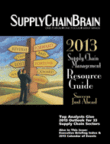
Home » Few Companies Are Prepared for Effective Product Recall
Few Companies Are Prepared for Effective Product Recall

March 12, 2013
Many industries and verticals specify that the software used within those industries be compliant. These stipulations include traceability, regulatory standards, tracking, recall management, lot, serial and batch tracking, expiration dates, etc. Enterprise software vendors have done an excellent job in creating software that not only complies with regulatory standards but usually exceeds them.
Certain industries may have software designed specifically for that vertical. Vendors that have solutions that are industry- and vertical-specific would be a good area to start narrowing the focus for a software solution that provides reverse logistical processes. Sophistication resides throughout the software to unite all aspects of manufacturing, billing, partner management, location tracking, supply chain, transportation and retail store distribution. These software solutions provide a vital piece of the infrastructure required to support any type of reverse logistical process.
Recent recalls span various industries and their products. Consider: lead in paint, defects in certain cars, tainted food. The supply chains these products must go through face intense scrutiny. Whether the software used can track the necessary requirements has become a question that board members discuss when selecting IT.
Today's software can contend with these standards easily. Often the disconnect within a reverse logistics process is the organization's ability to coordinate its own systems, infrastructure, partners and supply chain in a cohesive process. Processes are usually disjointed and only address one portion of the recall process and not an end-to-end process.
Take food as an example: As products are sourced, they are sold to wholesalers and chains and distributed to individual outlets. The process to invoke a recall consists of reversing every step and procedure that the product went through to get to the customer; the product then has to be retraced at every level to facilitate a full and effective recall. The gap that organizations face is that their method to recall products through their supply chains down to retail levels are often not complete and not executed properly. Procedures need to be put in place for coordination of partners, suppliers, transportation and systems to work in unison, to successfully track and trace a recall.
Outside of the systems and the physical logistics, communications is a major area that is frequently overlooked. Communication breakdowns usually occur at the supplier and distributor level. To relay the messages to all the proper parties is one aspect, and ensuring that the message is transferred unchanged all the way down to the consumer is of utmost importance. The communication plan plus systems traceability will ensure that organizations are properly prepared to facilitate a recall should one occur.
The Outlook
Organizations must find a way to interpret the data they already own, bridge deficient business processes and follow up with proper execution. They need to devise a strategy that includes communication and coordination of the entire supply chain down to the manufacturing component to facilitate a successful recall procedure. Organizations should not only have these processes in place but must be able to execute on their performance and tracking.
Keywords: reverse logistics, product recall strategies, supply chain risk management, supply chain management, defective products, reverse supply chain
RELATED CONTENT
RELATED VIDEOS
KEYWORDS Business Strategy Alignment defective products Global Supply Chain Management Industrial Manufacturing Logistics Logistics Outsourcing product recall strategies Reverse Logistics reverse supply chain SC Planning & Optimization SC Security & Risk Mgmt Supply Chain Analysis & Consulting Supply Chain Management Supply Chain Risk Management Supply Chain Visibility Technology
Subscribe to our Daily Newsletter!
Timely, incisive articles delivered directly to your inbox.
Popular Stories
-

-

Supply Chains Not Likely to Return to Pre-Pandemic Stability in 2024
-

Diversifying Production From China: Welcome to ‘The Great Reallocation’
-

U.S. Fleet Professionals Look Toward Sustainability to Cut Down on Rising Operating Costs
-

Next-Generation Packaging Brings Reliability and Visibility to Supply Chains

2024 Supply Chain Management Resource Guide: There's Only One Way Off a Burning Platform
VIEW THE LATEST ISSUECase Studies
-
Recycled Tagging Fasteners: Small Changes Make a Big Impact
-

Enhancing High-Value Electronics Shipment Security with Tive's Real-Time Tracking
-

Moving Robots Site-to-Site
-
JLL Finds Perfect Warehouse Location, Leading to $15M Grant for Startup
-
Robots Speed Fulfillment to Help Apparel Company Scale for Growth